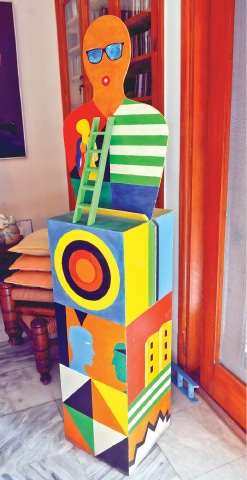“It is as if the viewer has been taken on an unnerving journey through dark alleys, sombre pathways, and the much desolate architectural spaces that eventually led to the inner world of the artist’s mind,” I wrote on the first solo exhibition of Moeen Faruqi, held in 1993 at Ali Imam’s Indus Gallery in Karachi. Faruqi reminisces about those days when he frequented the Indus Gallery which was housed in the understated residence of Imam Sahib. It is here that Faruqi met the Indian artist Francis Newton Souza who encouraged him to pursue his passion.
Faruqi’s studio today carries a sense of that past, naturally integrated into the spaces of his present paintings. The blue greens of the figures, a cat or fish, also seem to echo the jazz music one used to hear in his gatherings for artists and friends at his old Jamshed Road house. The artist, also a published poet, writes about his art in his poem, ‘Bay Window’ (Published in Breakups, an anthology edited by Shandana Minhas):
‘Outlines of the body
Intersection of curves,
Near the door to the balcony
A blue chair varnished
by the sun/
The sofa, a Matisse kind of red, envelops sounds of love,
Soon this will be a painting, a still mean in time/
The trick, say painters, is to capture this instant and never let it die,
You and I, by this window, connected in a never ending now.’

It is no coincidence, then, that Faruqi seems to have just stepped out of his own canvases. I ask him if he is in fact painting his own self-portrait, as the face seems to recur in most works. Here, he talks about the artists that have influenced him and among them is Anwar Saeed whose autobiographical figurative narrative is most prominent. One sees in Faruqi’s work another kind of space to Saeed’s, but the architectural divisions and the figures outlined in black present his story and those of people around him convey a similar sense of storytelling.
Moeen Faruqi’s studio showcases his own inspirations and influences
The connection of work that gives the viewer an impression of having seen this character or that in an earlier painting is due to the presence of Faruqi’s presence in that experience and exposes his vulnerability. He finds it difficult to relate to work where he cannot see the artist. For example, he questions the current trend of art on socio-political issues, because he feels that it is removed from the artist’s inner experience. That is why he feels that each painting by Tassaduq Sohail carries his signature style as: “It is an outcome of his inner feeling, and each painting is unique, similar to the way sentences are formed in a unique piece of writing. That kind of work carries with it the pain that issue-based work cannot.”

One can easily see the admiration for these artists, as his sitting area by the studio has a central work by him, flanked on one side by a large coloured drawing with life-sized figures by Anwar Saeed, and a large early canvas by Tassaduq Sohail with monsters and half-humans painted in his typical frenzied mark-making. There is pathos in these works, as there is in Faruqi’s depiction of characters showing unease in their urban setting.
There are works of seniors such as Nagori and Iqbal Hussain in his eclectic collection, a striking large figurative work by Naiza Khan, the early abstractions of Unver Shafi, and early drawings of Anwar Saeed, the late Shahbaz, Afshar Malik and many younger artists. He is drawn to the work of German Expressionists, Max Beckman, and to the Mexican artist Deigo Rivera since his early interest in painting. Being self-taught has allowed him to expand in the directions that his interest is in and reading and travel has led him to paint his story.

Published in Dawn, EOS, April 16th, 2017
















































Dear visitor, the comments section is undergoing an overhaul and will return soon.